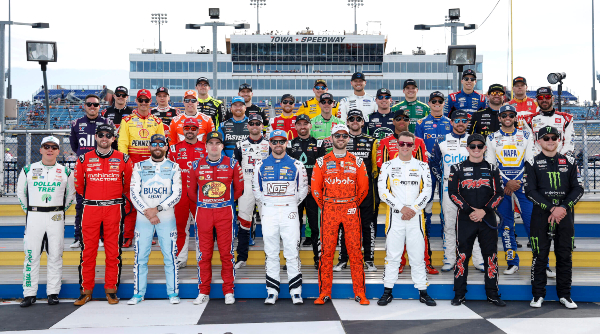NASCAR racing is as much a mental battle as it is a physical one. The high-speed thrills and split-second decisions that define the sport are paralleled by an equally intense psychological landscape. The mental toughness required to compete in NASCAR is formidable, shaped by pressures from fans, sponsors, teams, and the ever-present specter of personal and professional expectations.
The Pressure from Fans and Social Media
In the age of social media, the relationship between fans and drivers has become more direct and, at times, more brutal. Drivers are expected to maintain a public persona, engaging with fans through platforms like Instagram, Facebook and X, formerly Twitter. This visibility can be a double-edged sword. Positive interactions can boost a driver’s morale and public image, but negative comments can be deeply affecting.
Some drivers, like Martin Truex Jr. and Chase Elliott, prefer to keep their private lives out of the public eye, choosing to abstain from anything personal on social media to avoid the barrage of unsolicited comments and potential backlash. As Austin Cindric revealed in an interview with us last year, he chooses to manage the backlash by turning off comments and interacting only with friends. This approach helps to lessen the noise but it doesn’t completely eliminate it.
Sponsor Expectations and Financial Pressures
Sponsorship deals are the lifeblood of NASCAR teams, providing the financial support necessary for competition. However, these relationships come with high expectations. Sponsors expect drivers to not only win races but also to be effective brand ambassadors. Failure to meet these expectations can lead to the withdrawal of sponsorship, which can be devastating for a driver’s career.
The case of Kyle Busch and Joe Gibbs Racing serves as a stark reminder of this reality. When M&M’s pulled their sponsorship, Busch found himself without a seat, illustrating how fragile these relationships can be. The pressure to secure and maintain sponsorships adds another layer of stress, as drivers know their careers and the livelihoods of their teams depend on these deals.
Team Expectations and the Pursuit of Victory
The internal pressure within a team can be immense. Owners and team members have high expectations, and the relentless pursuit of victory is a constant burden. Drivers feel the weight of this responsibility, knowing that their performance directly impacts the team’s success. This was poignantly illustrated at the Chicago Street Race by Alex Bowman after finally breaking an 80-race winless streak. The in-car camera made it clear that Bowman struggled with tears before his spectacular burnout, and again during his post race interview wherein he acknowledged how difficult it’s been for him and his team since his concussion closely following by breaking his back. We saw the same kind of emotional response last year from Ryan Blaney after winning the 600. The relief and validation in his tears revealed the intense pressure he had been under with a 59-race winless streak which caused him to question his abilities and his future in the sport.
Kyle Busch’s recent struggles with his team’s performance issues highlight how ongoing setbacks can erode a driver’s confidence. When mental toughness begins to crack under such pressure, mistakes and temper tantrums often follow, further compounding the problem.
The Role of Spotters and In-Race Communication
Spotters play a crucial role in a driver’s performance, guiding them through the race and providing critical information. However, the dynamic between driver and spotter can also contribute to the mental strain. For example, Kyle Larson’s spotter, Tyler Mon, publicly criticized Larson over the radio, suggesting that Larson’s passive racing style allowed Denny Hamlin to take advantage of him. This comment, broadcast for other teams and fans to hear, clearly affected Larson, leading to an uncharacteristically aggressive move in the following race at Nashville, which resulted in a collision with Ross Chastain.
Such public critiques can challenge a driver’s self-esteem and decision-making, pushing them to prove themselves, sometimes to the detriment of their performance.
The Audition: Navigating NASCAR’s Contract Uncertainty
Unless a driver is fortunate enough to have a multi-year contract, the stress of securing a ride for the next season can be overwhelming, contributing to the already immense mental pressure. Every race can feel like an audition for a new contract. This reality hit home for the drivers of Stewart-Haas Racing, who learned the organization was closing its doors at the end of the 2024 season.
Drivers Noah Gragson, Josh Berry, Chase Briscoe, and Ryan Preece were faced with the fact that there are only so many seats available in the sport, and landing one would not be an easy task. Chase Briscoe managed to secure a spot with Joe Gibbs Racing, filling the seat left vacant by Martin Truex Jr.’s retirement. Similarly, Josh Berry landed a contract with the Wood Brothers to drive the #21 Ford. But ultimately, that displaces Harrison Burton, who now finds himself in the same precarious position.
This period of aggressive maneuvering, known in the NASCAR community as “silly season,” might more aptly be termed “suckerpunch summer.” The uncertainty and high stakes are reminiscent of a high-stress audition, where every race presents a make or break scenario.
Mental Preparation and Resilience
The mental preparation required to sustain the pressures of NASCAR is immense. Drivers must develop resilience and strategies to cope with the constant scrutiny and high stakes. This involves a combination of psychological training, support from mental health professionals, and personal coping mechanisms.
Drivers must learn to compartmentalize, focusing on the task at hand and blocking out distractions. Visualization techniques, mindfulness practices, and the support of a strong team are crucial components of their mental arsenal. The ability to bounce back from mistakes, maintain focus under pressure, and manage the emotional highs and lows of the sport is what separates the good from the great in NASCAR.
The mental toughness required to be a successful driver is unparalleled, so its essential to understand and address the challenges. The ability to navigate this complex psychological landscape is as critical as any physical skill on the track, highlighting the true depth of what it means to be a NASCAR driver.

